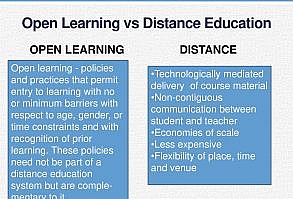The majority of the countries have some sort of distance education system. It is important to understand the dynamics behind this trend. First, it is foremost essential for governments to expand access to public services such as education. In this regard, distance education provides feasible solutions to particularly overcrowded and poor countries due to their huge populations. They might not afford to propose suitable and efficient public services to millions of residents. It is a challenge for them to hire enough teachers, build schools for the public and invest to improve quality. Therefore, it is demanding to address individuals’ needs with conventional education, which necessitates a paradigm shift in education.
Distance education alternatively could be a remedy for the deficits of conventional education in such densely populated countries. Distance education can facilitate reaching millions of students. The cost of distance education is an issue to consider once at the beginning although it is more affordable in the long term compared to conventional education. After the first establishment, it saves the initial cost in the following years.
Apart from public education, employees or in-service workers might need to revise or update their current knowledge. It is hard for adults to go back to school while working. Distance education, thus, provides a flexible learning environment. Overall, the demand for education is immensely improving worldwide, particularly in underdeveloped and over-populated countries. Serious thought should be given to distance education to solve this problem.
Second, educators invest effort in the instructional design of the courses along with professional teams during distance education. Contemporary educational technology has also been integrated into distance learning so that precise communication and interaction take place between participants. In addition, instructors are trained for such a paradigm change in course delivery. It was seen during the pandemic as many studies showed that in-service teachers’ technological pedagogical content knowledge had improved due to the training for the adaption to the new system.
Furthermore, the testing system is run by experts in distance education. Overall, it could be said that there is so much effort and specialization to implement distance education, which improves quality education. That is not possible in conventional learning since instructors are responsible for technology integration, course delivery, organizing materials, testing, and evaluation. Working under such a burden negatively influences instructors’ well-being and performance.
Third, distance education is more appropriate for those who live in an information society that refers to a huge amount of information being produced every day because Information society needs citizens who know how to access the information, find alternatives, and integrate information coming out of a wide range of sources. It briefly calls for well-educated people. It is another factor to increase demand for education.
However, it might seem nonsense to learn every bit of information about the target field due to the size and depth of knowledge. Schools in conventional learning, for example, force people to learn as much as possible and load an extra burden on students. This promotes functional learning. Individuals can learn the required information to properly accomplish tasks and duties at their job.
Distance education is capable of proposing learning opportunities to address this need. It also includes a better framework for lifelong learning as updating the fixed curriculum in conventional learning is a challenge particularly in countries that run the system from the center.
Fourth, the world has been going through globalization referring to the interconnectedness of the world’s economy, culture, interaction, information sharing. The essence of globalization is also reflected in distance education since countries need global citizens to trade, communicate, learn or teach others. Distance education systems collaborate and interact with each other across the world. That is why; globalization provides ample resources for distance education.
Please feel free to contact me if you need any further information.





